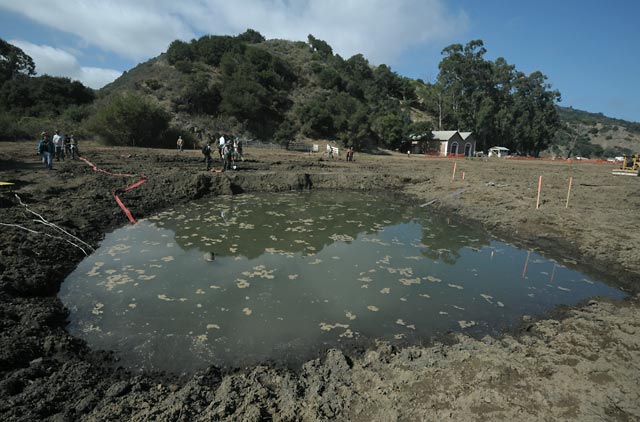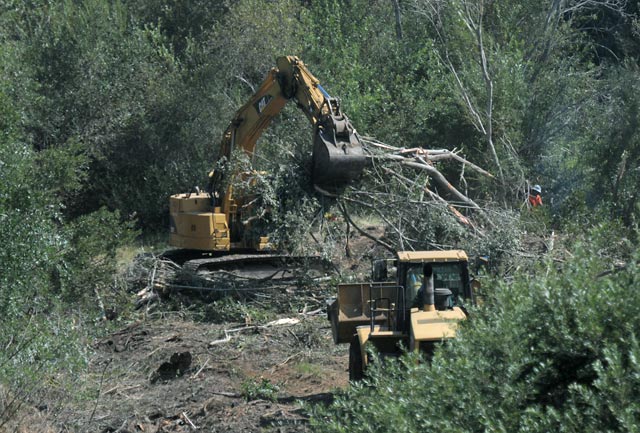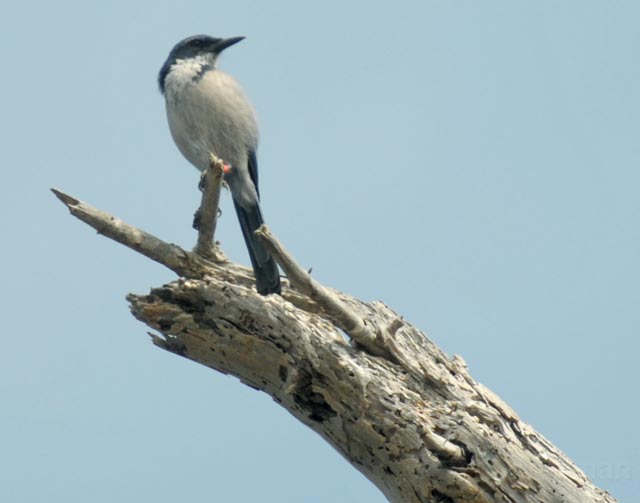Starting a Swamp
Restoring the Channel Islands' Largest Coastal Wetland

The roar of diesel motors, whine of chainsaws, and crunch of soils being scooped from the earth aren’t the typical noises that visitors to Santa Cruz Island expect to hear while wandering around Prisoner’s Harbor, a quiet landing where bright-blue island scrub jays and friendly foxes often outnumber humans. But on Monday, those rare sounds of heavy machinery were welcomed with wide smiles by the team of professional conservationists who’ve been working to start the ignitions for seven years now, all in order to restore what was once the largest coastal wetland on all of the Channel Islands as well as the creek that feeds it. All told, the $1 million project will cover 60 acres and serve a 13-square-mile watershed, enhancing land managed both by Channel Islands National Park and The Nature Conservancy, the nonprofit group that owns three-quarters of the island.
Explaining that 90 percent of California’s coastal wetlands have been paved over, the park’s Superintendent Russell Gallipeau said, “It’s time to give something back to the state.” Joining him in the ceremonial ditch-digging with a red bow-adorned shovel was the conservancy’s Lotus Vermeer, who applauded the public-private nature of the partnership. “Together we’re able to do this level of restoration work on the ground that no one organization could do on their own,” she explained. Others in attendance included wetland and hydrology experts from the National Park Service, archaeological monitors, consulting biologists, equipment operators, and a representative from the Los Angeles Conservation Corps, which sent in teams of at-risk youth to work for week-long spikes on the earlier stages of the project.
Specifically, the work will remove a 250-foot berm that had been built in the 1880s to channelize the creek and make the wetland usable to the ranchers who owned the island at the time, an era when wetlands and sloughs were routinely destroyed in favor of development. The crews will also move about 17,000 cubic yards of dirt from the historic site of the wetland, including the creation of two deeper ponds that should prove attractive to migratory waterfowl. And then moving up the creek, there are 1,800 eucalyptus trees that must go, as they suck up way more water than the oak trees and choke out other native species, such as willows, from the creek beds.

Though the heavy duty work started on Monday, the full project is expected to take quite a bit of time, and officials were reluctant to give estimates on an end date. Among other challenges still to be worked out is what to do with all of the felled lumber; eucs that have already been cut were chipped, but there’s been discussion of burning the downed trees as well.
When finished, the wetland — which will not experience tidal flow, as it’s technically a “back barrier wetland,” meaning that a naturally forming rock wall protects it from the ocean — will feature native flora and actively support the native fauna as well. In fact, when the first water appeared in one of the ponds earlier this month, the Park Service’s project manager Paula Powers said that four killdeer showed up within 15 minutes, and that the tiny ponds have since been frequented by kingfishers, heron, and, on Monday morning, an island fox. “The phrase: ‘Build it and they will come’?” said Powers, who later admitted to having dreams of heavy machinery that morning. “They’ve started to come.”

And once this week’s heavy lifting is done, more natural changes are expected to happen quickly. “The places that respond fastest [to restoration work] are the places with water,” explained the park’s natural resources chief Kate Faulkner. “We know we’re going to get a really rapid response.” Beyond the wetland, which also abuts a former Chumash village called Xaxas that was lived in for 5,000 or so years, the creek called Canada del Puerto will also revert to a more natural state, with a ribbon of willows down the middle, oak woodlands extending to the hills, and chaparral higher up the ridges.
The project, explained Faulkner, falls very much in line with some more controversial park initiatives in the past, such as the removal of rats from Anacapa Island by showering them with poison or the eradication of feral pigs from Santa Cruz Island via hunters in helicopters. “We don’t have the money to intensively garden the island,” said Faulker, so the plan is to remove the invasive species, “and the island will self-restore.”
To read the environmental report on the project, go here.



